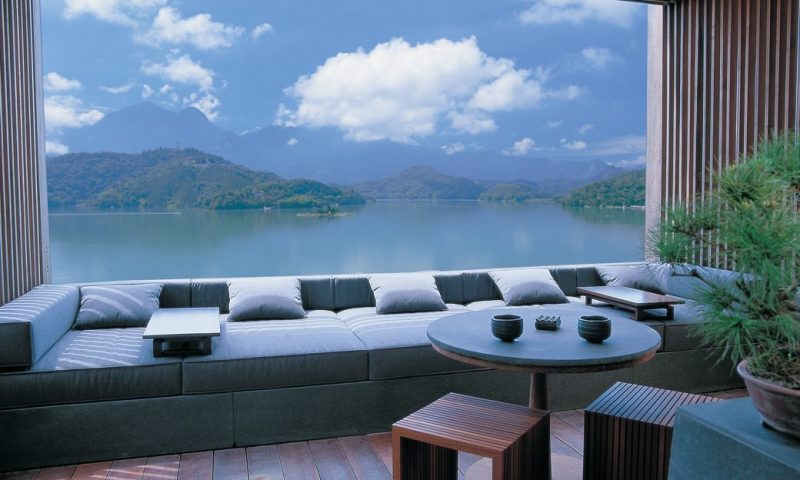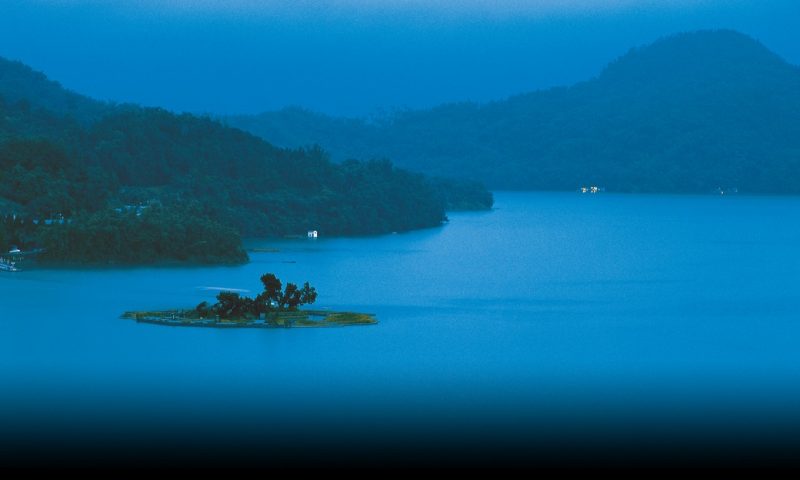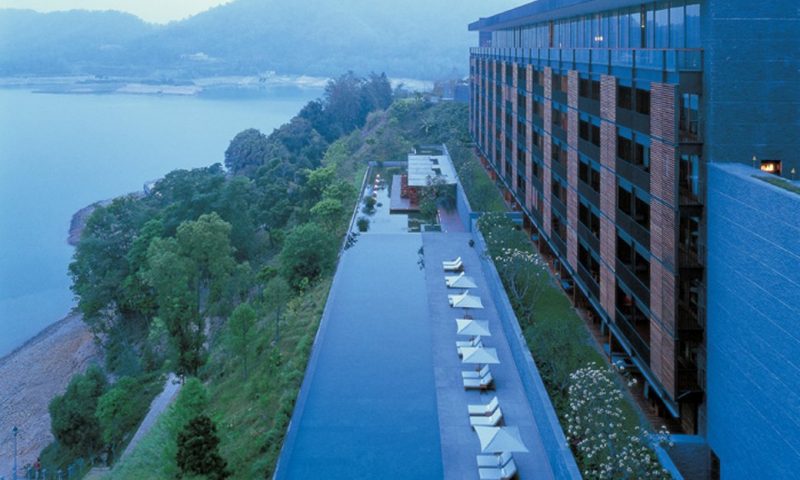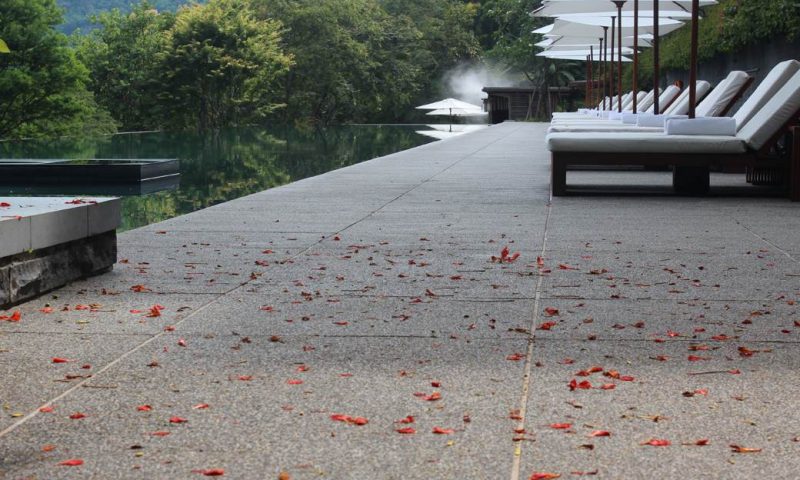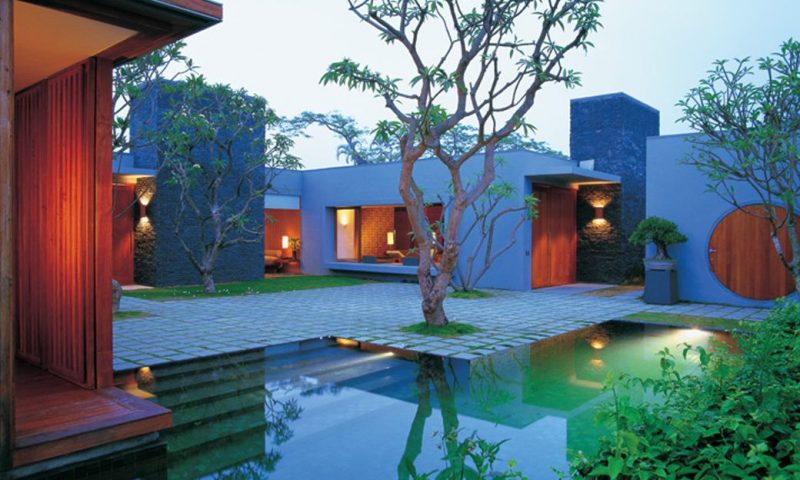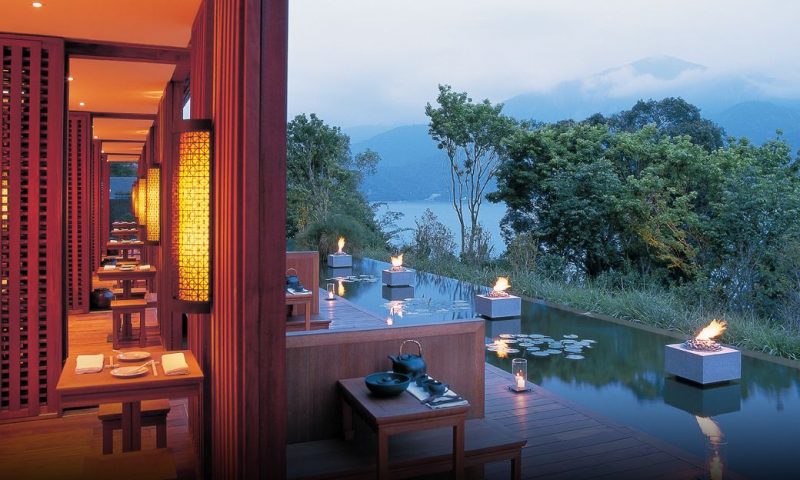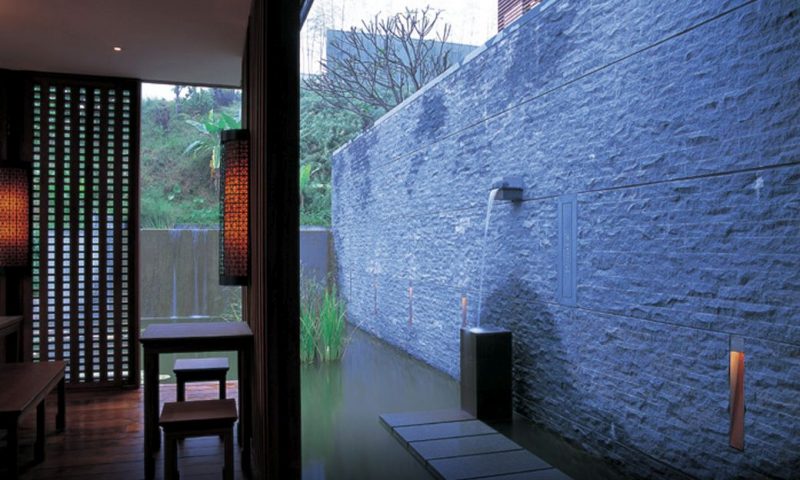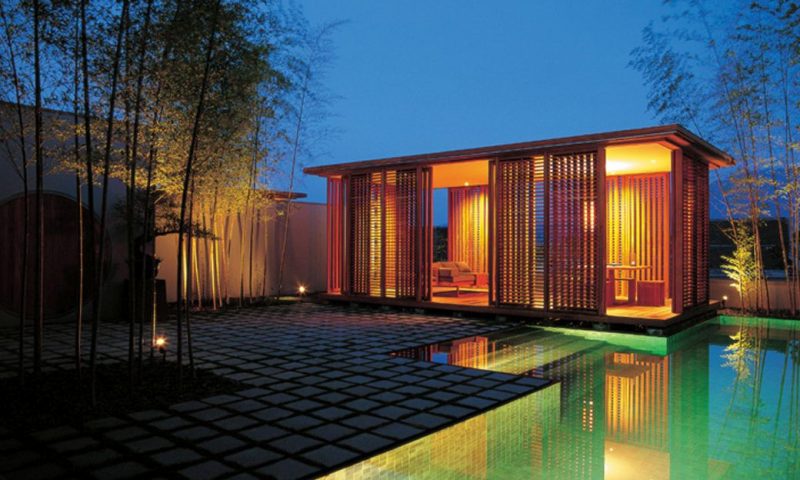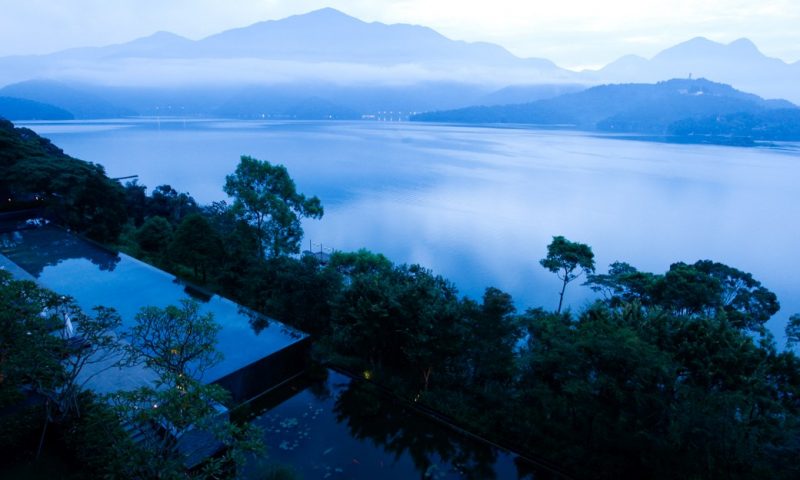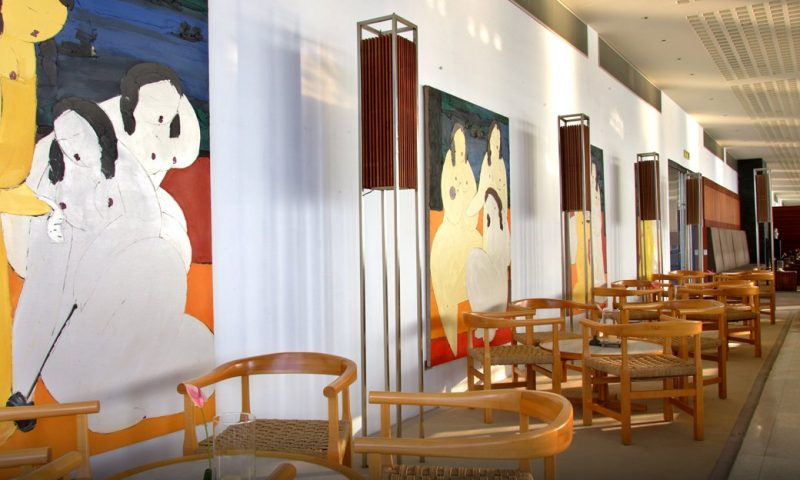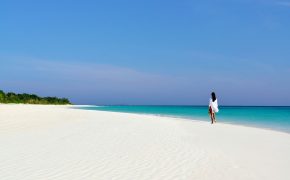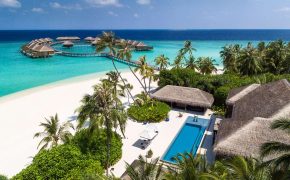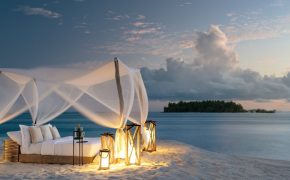If there is a name that can stir your emotions, it is The Lalu(Han Bi Lo in Chinese), even if each word in the name costs a hundred million dollars. In 1901, Mr. Ito built a small wooden cabin on the Lalu Peninsula for vacation use and called it “The Lalu”
For hundreds of years, with strict entrance control, only senior governmental official, generals, prime ministers, and emperors are allowed into The Lalu. Therefore, a myth is created to this building. However, how did The Lalu come about?
In 1923, the Japanese Crown Prince Hirohito visited Taiwan and appointed The Lalu to be his official residence. He rebuilt the small wooden cabin into a two-story building and added eight guest rooms, including the east and the west wings, dining room, conference room and more.
From this time on, The Lalu turned itself from a luxury vacation home into an official government guest house. In 1949, when the Chinese Nationalist Government retreated to Taiwan, The Lalu became President Chiang Kai-Shek’s hostel, used primarily for vacation use and to entertain foreign head of states.
In 1998, Mr. Cheng-Yi Lai, chairman of the Shining Group, received a phone call that filled his heart with tremendous excitement and doubt. For the past 30 years, his dream was to build a world class hotel along the shores of Sun Moon Lake. The man that made the phone call indicated to him that The Lalu was for sale.
However, buying this historical building was not going to be a simple task. Mr. Lai recalled and said, “Which name is always on people’s mind without ever needing any advertisement? This name has its place and historical value in public’s mind so the name itself is priceless. Even with millions that we spent on it, I think it’s still a bargain.”
After 5 years, using the theory of utmost simplification of Zen style as the architectural design core from our award winning international design team, the renovation of this historical hotel began.
It was rebuilt from the original palace style 6 story building, saving only its beams, columns and floor and replacing everything else. The new design divides the building into three separate building (building A, B and C) for different purposes.
Building A is the main guest house. Building B is the structure that houses entertainment facilities such as the Spa, gym, Jacuzzi and Members Clubhouse. Building C includes the Villa area, conference facility, Library and parking lot. On March 3, 2002, The Lalu reopened to the public with its new design and resort style 1.
About Sun Moon Lake
Sun Moon Lake is Taiwan’s freshwater lake. In ancient times, the area surrounding Sun Moon Lake was known as “Shuishalian”, translated meaning “where water and sand meet”.
Its area covered nearly half of Nantou County, including the township of Zhushan, Lugu, Mingjian, Shuili, Jiji, Puli, Yuchih, Renai and Guoxing.
Under the district of the township of Yuchih, located at the foot of Taiwan’s Central Mountain Range, Sun Moon Lake is situated between the island’s overlapping high mountains to the East and its plains to the West. Sun Moon Lake, Toushe, Yuchih and Puli are all basin terrain.
Architectural Features
The Lalu was designed by famous Australian architect Kerry Hill. Since he started his architectural firm in Singapore in 1979, Mr. Hill has won numerous design awards, such as the 2001 Aga Khan Award for Architecture.
His projects can be seen throughout South East Asia, Australia, Japan and USA. Mr. Hill specializes in holiday resort architectural project, with outstanding projects such as The Amannusa in Bali, The Datai in Langkawi, The Aman Resort in Hawaii and The Darwin Centre in Australia.
He named his architectural design for The Lalu as “Ongoing Style”, a unique style of moving forward. This type of architectural style will remain fresh even after 10 or 20 years, being an architecture that will be still full of value.
Other than the unique architectural design of The Lalu, our architectural team also paid special attention to the hotel’s lighting effects. Lighting effect was integrated into the planning right from the beginning.
Lighting designer Nathan Thompson, who teaches lighting arts classes at the Melbourne University in Australia, creates lighting effects for major performing arts groups worldwide and continues to cooperate with major architects in lighting designs.
Using effects such as contrasting light and shadow, brightness and dimness, Mr. Thompson excels at using lighting to accentuate objects, create desired moods and produce mystical and dramatic effects. His lighting design appears as splendid as silk brocade or as flowing layers of grain in wood.
The lighting effect at The Lalu harmonizes with the changing intensity of natural sunlight and is never harsh. Each day, seven lighting changes occur at different time periods and in different settings.
At night, the graceful motion of branches and leaves are made visible by lights projected from the treetops to the ground. Lighting at The Lalu reminds us of a line from a famous poem: “Just as the shadows of flowers are carried away by the setting sun, the moon appears and harkens them back”.
Rooms
The moonlight, under the cover of the darkness, reflects into the rooms, so that anyone that has this experience will never forget it.
Each Lakeview Suite (One-Bedroom) has a spacious living room and two individual bedrooms that can provide luxury relaxation for the whole family. With separate rooms and individual privacy, parents can spend the vacation like it is their second honeymoon while still being close to their children.
Each suite has a balcony approximately 10 pings in size (about 25 square meters) that is large enough for the whole family to enjoy the inspiring views of Sun Moon Lake together 1.
The Courtyard Pool Villa (Two-Bedrooms) has a spacious living room, fireplace, dining room, kitchen, two bedrooms and a 12 meter long private, temperature-controlled swimming pool for you to enjoy with your family.
If you are tired from swimming, you can rest in the half-open teak pavilion next to the pool and enjoy the light breeze and the beautiful afternoon sunlight.
When night falls with its beautiful moonlight, creating a soft evening atmosphere in the background, this becomes the best place to invite your family and friends for a moonlight party.
Scenic Steps Inspired by the Great Wall
At the first look, these steps do not seem to be very long. However, after climbing and after a few turns, then you realize that you cannot see the end. Thus, in fact, it is quite a distance.
These steps have an overall height of a 10 story building, but it does not seem that high. You will feel a bit tired after climbing the whole steps but in theory, climbing a 10 story high steps should make you feel very exhausted.
This is where the design of these steps gets intriguing. Under the strict guidelines from the designers, the height and the level of the steps have to fit human ergonomics therefore making it more gentle climb.
The final results are the height of each step being 15cm high and 30cm deep; with this design, the steps are most comfortable. We incorporated the military purpose raised battlement design in the Great Walls of China.
In our designs; instead of rising, we sink the battlement so it creates a functional viewing of the surrounding natural environment. The height is higher than a normal window so the lake view will burst into the scene. This creates a looming mysterious atmosphere that will intrigue our guests.
Secrets of the Full Water Level
The Lalu swimming pool is designed using the theory of “Overflow”. What the “Overflow” theory is about is using water surface tension to create a smooth quiet and mirror-like visual effect. When you are resting by the pool side, as the edges of the pool are out of sight, a borderless view is created.
When you are swimming in the pool, the height of the pool connects the sights of the pool, lake and the sky into a line creating a fusion effect of the blue-green of the lake, the light blue of the pool, and the blue of the sky. This is a perfect fusion of visual effect.
Sceneries that so unique that can only be found he
The Lalu is ideally situated besides the mountain and the lake. Right from the beginning of the design process, we not only considered the view from inside The Lalu but also considered the visual effect when viewing the building from the lake.
Our design team took a lot of consideration on how to best incorporate the piece of land between The Lalu and the lake so that it can be both visually pleasing and environmentally friendly.
Sceneries so beautiful during anytime of the day
On an ordinary day of March, in the face of gentle spring breeze, green sprouts are spotted on the tips of trees, new pistils of cuckoos bust out over night, spring breeze are warmly welcomed by waves of peach blossoms.
Mirrors that shifts its light by the shadow.
Needless to say, reflection pool is like a brass mirror that travels through time, lights up the entire Sun-Moon Lake. Sun-Moon Lake after rain, with her reflection on the pool as radiant as a polished mirror.
As the day is approaching dusk, light breeze in the air, light up the candles one by one then slowly place each of them in the pool, as daylight gradually turns dark, night time arrives, the candle lights swaying on water create a scene bears the resemblance of heaven, not a trace of ordinary life could be detected.
Ongoing style architectural design
Ever since The Lalu was reopened to the public, the building became an instant landmark in Sun Moon Lake.
Many people stay at The Lalu because they want to experience the building for themselves. Since The Lalu has become a famous landmark, it is also a design that is widely copied but never quite the same.
Our architectural designer, Mr. Kerry Hill, is a highly celebrated designer in the architectural society. Ever since he started his architectural firm in Singapore in 1979, his firm has won numerous international awards.
Using his philosophy of starting a design from scratch, his work captures the imagination of the public. His conviction and determination in architectural design often create his projects into art pieces that hold lasting values. The Lalu clearly demonstrates his vision and spirit.
The Lalu Memorial Hall
The Lalu Memorial Hall is situated on the right side of the main entrance. Built in 1901, this is the only building that survived on the Lalu Peninsula.
It was first used as an official guest house during the Japanese occupation. In the period from 1940 to 1970’s, it was one of President Chiang Kai-Shek’s many summer vacation homes.
Hanbi Hiking Trail
Hanbi Hiking Trail used to be called President Chiang’s Trail, and it has a total length of 1.5 kilometers. It is a trail that winds through Lalu Peninsula.
Covered with trees, with bird chirping and butterflies dancing, lighting changes with the trees, and there is always a chance to catch a glimpse of the lake view through the gaps of the trees.
In the morning, it has a refreshing feel while in the evening, the scenery becomes poetic. If there is a light sprinkle of rain present, it adds even more to the poetic feel to the surrounding
The Xiangshan Visitor Center
The Xiangshan Visitor Center is at the start of this path. This is an eight-kilometer stretch of path from Syuanzang Temple through Huantan Tunnel No.1 to the Mingtan Water Outlet.
The path is designed mainly for cyclists and meanders through the beautiful scenery, giving cyclists a wonderful view out onto the Toushe Basin to the south and Qinglong Mountain to the north, making this path a great choice for cyclists.
Shueishe Lakeside Trail
This trail goes from Shueishe Wharf to Jioulongkou with a total length of 1.5 kilometers. It is a new trail that is constructed from raised wooden planks and is built along the lake, allowing people to observe the lake close-up.
Many natural pontoons can be seen on this trail, which provide an excellent ecological environment for the numerous aquatic species living here. Along the way, there are various viewing platforms where people can view the mountain on the other side of lake.
Along the path, you can view a special floating islands called Ukida that can only be found in the Sun Moon Lake. It is interesting to observe how the lake fishes search for this island to spawn, making this something you can only see in the Sun Moon Lake.
Maolan Mountain Hiking Trail
Maolan Mountain Hiking trail is about three kilometers long with its entrance located beside Longfeng Temple. This trail is divided into two sections. The first part winds its way along the tea terraced walkway to The Maolan Mountain Tea Research Station.
The most famous specialty of Yuchih Township, the Assam tea, are planted along the path. Nesting beside the mountain and facing the lake, The Tea Research Station is one of the best locations to view sea of clouds at sunrise that appear at Sun Moon Lake.
The second part of the trail from The Tea Research Station to the Sun Moon Lake Weather Station at the tip of Maolan Mountain is a trail that will make you exercise. This 2 kilometers stretch has Ceylon olive tree trail and tall Taiwanese Shanlin Tree along its path along with insects and robins singing for you.
Once you reach the tip, you can view the Chiufenerhshan and Chi – Chi Mountain and be amazed at the beauty of nature. . The one hundred meters long Ceylon olive trees trail is Yuchih resident’s private attraction.
Red leafs falling off these burly trees covering the trail making this a very romantic trail. It also serves as a popular place for wedding photography.
Xiangshan Bike Path and Pedestrian Bridge
Starting the hike from Shueishe Visitor Center, travel west alone the lakeside trail. Along the way, you will pass under Longfen Temple and go around the village of Beitan Bay and finally reaching Shueishe dam.
Once you reach the dam, you can pay homage to the Martyr’s Monument and visit the Sun Moon Lake Legends Pavilion. While there, you can listen to the legendary old man Mr. Zhang Liangui stories.
Continuing down the path, you will reach the Xiangshan Visitors Center, where you can enjoy the work of a master architect while sipping mountain flavor coffee. After the visitor center, the path continues on to Minghu Lake outlet and finally merging with Sun Moon Lake Bike Path.
Sun Moon Lake Bike Path
With the Xianshan Visitor Center as starting point going past Mingtan lake outlet, Crescent Bay, Huantan Tunnel No. 1 to Syuanguang Temple, this path‘s distance is approximately 8 kilometers long.
This path is custom designed for cyclist. This trail along the south bank of Moon Lake Wanting shuttles along ecological and forest rich environment. Half way into the path, you can see to the south Toushe Basin and to the north Mount Qinglong, making this trail a great choice for cycle enthusiasts.
Especially from here overlooking the Toushe basin and looking downwards, farm houses are arranged like pieces on a chessboard. This scene reminds us of paradise under the writings of Yuanming Tao.
Toushe Bike Path
Toushe is a small village located south-west of Sun Moon Lake with altitude of approximate 640 to 670 meters which is about 80 meters lower than the Sun Moon Lake. These features make this a flat terrain and very suitable for cycling.
The starting point of this bike path is right beside Taiwan Highway No. 21 and the way to identify the bike path is to look for a statue of a boy riding a cow. Toushe Basin area is only about 2 square kilometers.
The terrain is almost flat and with farm houses together with the green pasture and egrets flying. Riding in these small farm path actually make it look like you are in a beautiful painting.
Meihe Garden
The Meihe Garden is located at the west side of Shueishe Wharf. This site was a military police station used to guard The Lalu. The old military police post is now a bar overlooking the lake.
Walls made stacked pebbles and corridors made of European wood embraced by roadside plum and wild cherry tree, blooming throughout the seasons gives this garden a classical romantic feel.
The Church of Jesus
The Church of Jesus is situated right beside Meihe Garden and was built in 1971. It was built for President Chiang and his wife, so when they vacationed here they have a place for worship on Sundays.
Built under Colonnaded white Roman architectural style the church still has unadorned and elegant style. Inside, seats are made of red cypress and to this day the sofa exclusively seated by President Chiang still remains.
Both sides of the stone staircase are lined with Dragon Chinese Juniper which was one of Presidents favorite plant and in the backyard, plum trees were planted. With the end of the authoritarian era, The Church of Jesus can finally remove its mysterious veil and be opened to the public.
It is open to the general public during their opening hours and open to application for religious wedding services. Open daily from 09:00 to 17:00, with Sunday service from 15:30 to 16:30 on Sundays.
The Shueishe Dam
Shueishe Dam is located on the west side of the Hanbi Peninsula. Total length of the dam is about 300 meters and the direction is east to west. Being part of the Sun Moon Lake Reservoir Project, Toushe and Shueishe damn was built to hold the water from the gap of the lake.
The embankment is full of green grass and the dam overlooking the lake is a very beautiful scene. During the day this is a very popular spot for photographers and many couples have their wedding photos taken at this spot.
During the night, this is a great spot for stargazing. At the west end of the dam road, a martyr monument was built to honor the workers that lost their lives during the construction of the dam.
The Longfeng Temple / Matchmaker Temple
Longfeng Temple is located on the Taiwan Highway No. 21, and it is very close to the Maolan Mountain hiking trail. The temple was originally located at the shore of Shueishe Lake and it has to relocate to its current location due to the construction of the dam.
The main shrine of the temple worships the Being Ashamed Patriarch. In the temple, there is a commanding view of the Beidan Bay and Moon Lake.
Matchmaker Temple was originally located on Guang Hwa Island and was destroyed by the 921 earthquake. After the earthquake, it was relocated to east side of the Longfeng Temple so that it can continue to create and continue the Lovers Lake legacy.
Maolan Mountain Tea Research and Extension Station
In Taisho 14 years (1925) of the Japanese colonial period, Japanese imported Assam tea from Assam Province, India to test plant it at Yuchih, Nantou. Since Sun Moon Lake region share the same type of weather as Assam region in India, which is mild temperature and humid, the test plant was a success.
It has become a stable of this region and with successful promotion, making Sun Moon Lake Assam Tea a famous brand name. The Tea Research and Extension Station Yuchih branch is located on Maolan Mountain. It is divided into new and old tea plantations.
The old tea plantation is a three-story wooden building that was kept since the Japanese colonial period and to this day still does tea research and development.
Both sides of the tea plantation are surrounded by tea trees and with the view afar of the lake and Yuchih township, making it a very pleasant scent. Traveling past the Tea Research Center and toward to end of the path is the Sun Moon Lake Weather Station.
The path is covered by rows of Ceylon olive trees and red leaves on the ground, making it quite a romantic walk. The weather station sits at elevation of 1020 meter above the sea level, and it is one of four Alpine weather stations in Taiwan.
The view at the weather station is spectacular. Currently the Tea Research and Extension Station are not open to the public. The Weather Station is open from 05:30 to 17:30.
